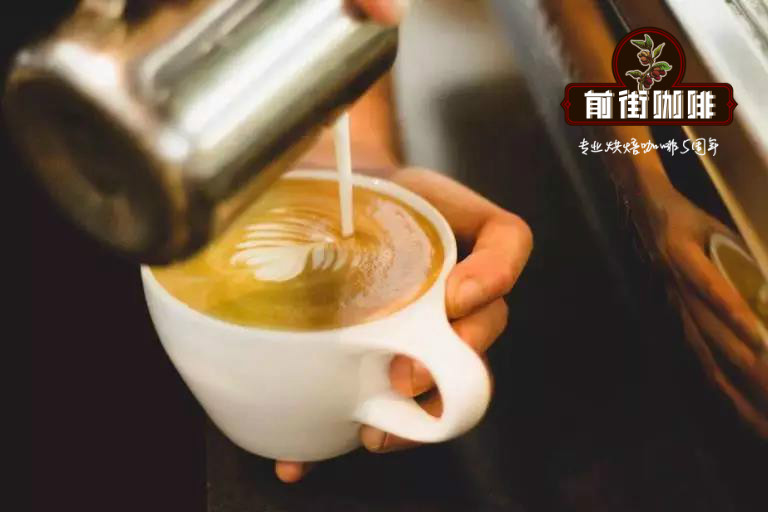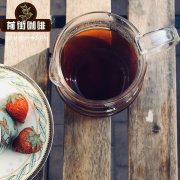What is the reason for making a coffee latte, beating milk without bubbling and layering milk foam?

Professional coffee knowledge exchange more coffee bean information please follow the coffee workshop (Wechat official account cafe_style)
First of all, you have to buy a steel cup (above 16oz capacity is recommended, otherwise it is too small and difficult to operate) and a thermometer, for example, mine is CDN IRB220-F.
Secondly, ls is wrong. The hotter the milk is, the more difficult it is to blister. Generally speaking, from cold milk to 58C, you can almost insert the nozzle into the inside of the milk for pure heating.
There is a red alert temperature zone on the thermometer, between 66 and 77 degrees C, heating to no more than 77 degrees C, otherwise it will destroy the nutrition of the milk and pull out the steam stick.
At this time, the temperature in the furnace is still boiling, but it is best to extract coffee oil at 93 degrees C, so turn off the switch that heats up to steam, then let go of excess steam and some hot water, so that the temperature falls below 93 degrees Celsius. When the temperature lamp for coffee extraction is off and on again, the handle filled with coffee powder is put in for extraction.
The steam pressure is controlled by the steam pressure valve through the advanced espresso machine, or by the height of the knob and nozzle from the milk level. The closer the distance is, the finer the foam is.
In addition, foam fineness can also be increased by buying nozzle accessories, such as Rancilio's 3 Hole Steam Tip, which is a great three-hole nozzle to upgrade his Silvia.
Steam can also buy an electric bubble stick, such as my aerolatte stick, the disadvantage is that cold milk is easy to beat, but it is easy to heat the foam after beating, and it is difficult to heat the milk before heating it.
In addition, milk with high fat content is more likely to bubble, and friends who generally do not drink whole milk can also consider adding half-half in order to bubble.
Some milk content is too low, it will not bubble, it is best to use whole milk.
For example, breakfast milk is very difficult. Generally, if you want to make milk foam, you need at least 3% fat.
The reason why milk can make foam is to inject air into the fat bubbles in milk, and the protein in milk also plays a certain role in the formation of milk bubbles.
First drain the water vapor and keep it dry.
The steam outlet is a little below the surface of the milk, and then turn on the steam. If you don't hear the prickling sound, bring the steam outlet closer to the surface. If you hear too much noise, you need to keep the steam outlet a little more below the surface of the milk. (depending on the adjustment of the height of the milk tank)
1. Milking is completed before 40 °. After 40 °, the milk is overexpanded and foamed again, which makes the milk foam unstable. And how to judge 40 °? Our body temperature is 37 degrees, so it needs to be done before we can feel the temperature.
two。 The steam orifice is formed on the surface of the milk. if it is vertical, there will be less foaming per unit time, and the greater the tilt angle, the more foaming per unit time. This can be judged by the sound of foaming. If the machine steam is big enough, it will be drier.
3. The time of milking is judged by the length of the prick sound you hear before 40 °. The difference between Cabo and latte is that the length of the sound continues to be controlled.
4. Then heat the milk and rotate it. The reason for the rotation is to distribute the foam evenly, and to rotate so that the foam and the foam collide with each other, creating micro-foam. If you make it more stable, the milk you beat will produce luster.
5. To finish the heating, you need to empty the steam outlet and wipe it.
When the milk is breathed into air, the larger bubbles on the surface will gradually disappear with the rotational motion, and after there are no obvious air bubbles on the visual surface, the milk liquid has basically been beaten into dense milk bubbles in a small foam state. this basically completes the morphological transformation from liquid to milk bubbles. At this time, the left hand can lift the milk tank slightly and bury the nozzle under the surface of the milk. after that, the temperature of the rotation process will continue to rise. at this time, pay attention to the temperature felt through the surface of the milk tank. If it is estimated to reach about 55-60 degrees, it shows that the foam is basically in place and the steam stick can be turned off. But this inspiratory upward movement must be careful and subtle, and there must not be too much shaking, otherwise it will destroy the structure of the milk foam and lead to foam failure. The criterion of getting rid of foam is to see whether it is dense and delicate and has good fluidity. If the milk foam hit too much and light foam is also considered a failure.
For those of you who use the home coffee machine to play with flowers, if you can't make even and delicate milk foam all the time, please don't be depressed. If your steam stick is similar to the one in figure 1 with no nozzles, and you can observe small holes in the steam bar shell, then your position of bubbling may need to be different from that of ordinary nozzles-you don't need to insert the liquid surface, enter the air or think about the wheezing noise, just bury the milk from beginning to end and stir up the whirlpool.
For more professional coffee exchanges, please scan the code and follow Wechat: qiannjie

Please indicate the source of the reprint.
Important Notice :
前街咖啡 FrontStreet Coffee has moved to new addredd:
FrontStreet Coffee Address: 315,Donghua East Road,GuangZhou
Tel:020 38364473
- Prev

How to time the cooking by hand? What's the difference between one-size-fits-all flow and segmented extraction?
Professional coffee knowledge exchange more coffee bean information please follow the coffee workshop (Wechat official account cafe_style) [question 1] Q: why can milk make milk foam? The basic principle of milk foaming is to use steam to beat milk, to make liquid milk into the air, and to make use of the surface tension of milk protein to form many small foams and make liquid milk volume.
- Next

Which tastes better, the difference between cold coffee and iced coffee?
Professional coffee knowledge exchange more coffee bean information please follow the coffee workshop (Wechat official account cafe_style) what is cold extracted coffee? Cold-extracted coffee English Cold Brew Coffee, also known as cold-brewed coffee, ice-brewed coffee, cold-brewed coffee, is the coffee liquid that puts the ground coffee powder directly into normal temperature water, soaks and extracts for more than 12 hours, and then filters out the coffee liquid. Also
Related
- What is the meaning of lactic acid fermentation with coffee bean treatment?
- How to judge the state of foam by sound?
- How does the latte pull out the unicorn pattern? Come to get for a little trick to improve the flower pull!
- Will flower pulling affect the taste of the latte?
- Do you know the history of coffee?
- The difference between honey treatment and sun washing what is raisin honey treatment?
- What kind of milk can a novice use to make coffee foam to keep the foam longer? The correct method and skills of milking tutorial sharing
- Why do washed coffee beans taste sour? Flavor characteristics of washed Coffee
- Introduction to the skill of how to practice the size and height of water injection around the circle of hand-brewed coffee
- How do beginners practice coffee flower drawing from scratch?

